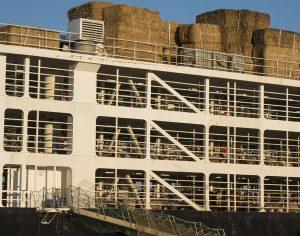City, Gatwick, Heathrow, Luton, Southend and Stansted: there’s no shortage of airports surrounding London and yet the capital’s air traffic is an issue. Heathrow expansion campaigns have rattled on for years, largely with inaction. However, in June 2018 the government granted approval for a third runway, although completion is still reportedly eight years away at the earliest if the build goes ahead.
But Elite Global has discovered Stansted may seemingly be the airport to watch. We were there for the UK launch of Primera Air, the Icelandic airline on course to create turbulence in the British travel market with low-cost transatlantic flights. While the benefits for consumers are obvious, with one-way flights to New York from £149, Primera is equally keen to service the needs of businesses in the surrounding areas of Essex, Cambridge and London, revealing a 50/50 split between business and leisure passengers.
Stansted is an essential part of the airline’s strategy for conquering the UK, says Ken O’Toole, CEO at London Stansted Airport. “Businesses and local residents have been very clear to us they don’t want to have to commit up to three hours trekking around the M25 to get to Heathrow. You look back to the development of easyJet and Ryanair and what they’ve done for prominent low-cost developments – it was an easy decision for Primera to make.”
In addition to the location, Stansted provides Primera growth opportunities neither Heathrow or Gatwick could manage, according to O’Toole, who described the airports as “effectively full.” 26 million passengers travelled through Stansted in 2017, which is expected to reach 29 million in 2018. And currently the airport has a cap of 35 million a year but an application is in place to have that extended to 43 million, so there’s certainly potential to scale, which aligns with Primera’s “strong growth ambitions.”
But how can Primera offer such low prices to fly across the pond? While sitting on-board a Primera Airbus A321 Neo plane with Anastasija Visnakova, chief commercial officer at Primera Air, she tell us it’s all down to technology. “Traditionally these planes are used for short haul,” she says. “Now with technology it allows you to fly over the pond, which is quite a game-changer in the industry.” Having operated in the Nordics for 14 years though, you may wonder why the airline didn’t launch in the UK sooner. Visnakova explains the timing is now right because consumer awareness of, and desire for, low-cost airlines is higher than ever. Primera’s fuel efficiencies mean costs are 25% to 40% lower than those from older aircrafts. “We’re making expensive transatlantic flights history,” she explains. “Even with all the money in the world, people want a bargain. Why not pay £400 and sit in premium class instead of £2,000 in business class?”
Whether you’re a consumer or growing business owner, it’s hard to argue against the cost savings to be had. Particularly as premium class promises larger seats, priority boarding, check-in baggage, meals, drinks, pillows and blankets. However, despite the ease on the wallet and facilities on offer, Hrafn Thorgeirsson, CEO of Primera, admits the airline isn’t for everyone. “Primera Air will be attractive for a big majority of the population but we’re not for everyone,” he says. “If you want a lie-down seat, first class service or big lounge, we’re not the airline for you. But most people aren’t in that category, we’re almost taking about the 1%.”
Thorgeirsson is under no illusion some will stick with legacy carriers but Primera is comfortable in its own skin, so its approach to make an impact in the UK is ready for take-off. In fact, he expects the titans of travel to follow low-cost carriers. “What I think is going to happen is they’ll imitate us more and more,” he says. Indeed, more airlines have cut prices by removing things such as baggage allowance as standard in a bid to offer more consumer choice and entice a broader demographic but that doesn’t guarantee an easy win. Go Fly, British Airways’ low-cost airline, ran for just three years from 1998 before subsequently being merged with rival easyJet. “They have a much higher level of cost already, so it will be difficult to copy for all kinds of reasons,” says Thorgeirsson of legacy airlines, pointing to things such as aircraft and crew fees.
Interestingly, operating an airline today requires a culture startups will be very familiar with, explains Thorgeirsson. “You have to have a special spirit which you don’t often find in the hallways of airlines that have been around for decades,” he says. “We’ve been very quick to adapt ourselves to the ever-changing winds in aviation.” He refers to oil costs, fluctuating currencies, politics and other events being out of their hands, noting that speed is essential to survive. “You have to have a flexible organisation to move very quickly. I think it’s been created by itself because we’re a relatively young airline. It’s important to never forget your objectives and that’s to kill any unnecessary cost. That’s the only way we’re going to be profitable and still offer very low prices.”
In addition to biting into the Big Apple, Primera will fly from Stansted to Washington DC, Boston and Toronto by the end of the summer and Thorgeirsson believes the UK could account for 40% to 50% of the overall business within three years. “We’re still small, very flexible and we can move around so we can tweak things,” he says. “If this was a war, we’re guerilla. A major army like the legacy carrier can go against us and lose. It will be a challenge in the coming years if we are successful in maintaining this spirit. Right now it’s alive and dynamic in the company, so I don’t foresee it as a problem in the next two to three years but we have to be conscious all the time about where we came from and where we want to go.” ![]()
Share via:


















































